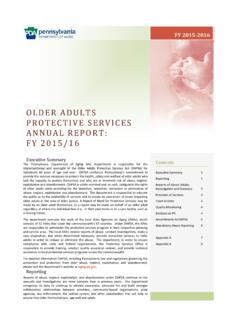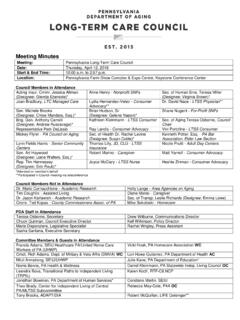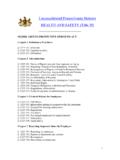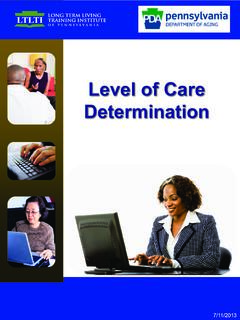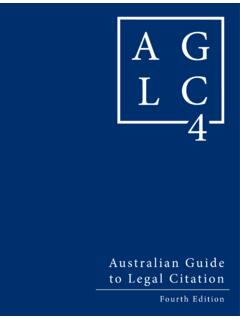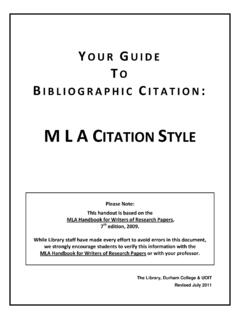Transcription of icensing I - Pennsylvania Department of Aging
1 Adult Residential Licensing L. icensing I. nspection G UIDE. A Tool for Adult Day Services Center Operators and Stakeholders 6 Pa. Code Chapter 11. July 1, 2015 Edition 1. Table of Contents Introduction 3. How to Use the Licensing Inspection Guide 4. PART 1 Regulations, Discussion and Primary Benefit 5. Index of Regulations 6. General Provisions 8. General Requirements 13. Staffing 23. Physical Site 33. Fire Safety 46. Program Components 54. Discharge Policy 62. Center Services 65. Health 70. Medications 73. Nutrition 80. Transportation 84. Protective Devices 86. Client Records 88. Legal Entity 92. Application 93. Inspection 94. Fees 95.
2 Licensure 96. Negative Sanctions 101. Appeals 103. PART 2 Regulatory Issues and Frequently Occurring Situations 104. Abuse and Abuse Reporting 106. Certificate of Occupancy 108. Criminal History Background Checks and the Older Adult Protective 109. Services Act (OAPSA). Prohibitive Offenses in OAPSA 112. Egress: Obstructions, Locks and Courtyards 114. Fire Drills and Evacuations 115. Plans of Correction: Developing, Implementing and Verifying 117. Compliance PART 3 Appendices 120. Appendix A: Reportable Incidents 121. Appendix B: Examples of Applicable Laws 122. Appendix C: Serious Communicable Diseases as Defined in 28 Pa. 123. Code Appendix D: Inspection Procedures and Methodology 125.
3 Appendix E: Adult Day Care Center Self-Inspection Worksheet 128. 2. Introduction What is this guide, and why do I need it? The Older Adult Daily Living Center regulations, 6 Pa. Code Chapter 11 became effective on October 12, 1993. These regulations govern the operation of older adult daily living centers, commonly known as adult day services centers in the Commonwealth of Pennsylvania . This guide is meant to help center operators and inspectors better understand and interpret the regulations. This Licensing Inspection Guide (LIG) has been developed to provide clearer explanations of the regulatory requirements of 6 Pa. Code Chapter 11 to help adult day services operators provide safe environments and effective services to clients through regulatory compliance and to improve consistency by licensing representatives.
4 It provides a detailed explanation of each regulatory requirement, including expectations for compliance and guidelines for measuring compliance. This guide is a companion piece to 6 Pa. Code Chapter 11; it should be used along with the regulations, not instead of them. The explanatory material in this guide is not meant to be new regulations or to extend the meaning of the regulations beyond their original intent. 3. How to Use the Licensing Inspection Guide Each regulation that can be qualified for compliance during an inspection is included in the LIG. and is accompanied by clarifying information. The illustration below shows how regulations are presented, and how inspectors and centers can effectively use the LIG.
5 (e) A copy of an unusual incident report This area presents the regulation relating to an individual client shall be kept in exactly as it appears in Chapter 11. the client's record. The Discussion section provides Discussion: A copy of all reports must be retained in the information about applying the client record. Retention of the incidents in residents' records regulation, including referencing other is in accordance with (2). regulations and applicable narratives. Inspection Procedure: During the inspection, the licensing The Inspection Procedure section representative shall review client files to confirm unusual describes how compliance will be incident reports are filed in the client record.
6 Measured. Primary Benefit: Permits centers to review reports to The Primary Benefit section identify and address patterns of incidents and conditions that explains how the regulation protects may otherwise be a source of harm to clients. residents' health, safety, and well- being. Recommended . Throughout the LIG, you will repeatedly see the words recommended or strongly recommended. These words indicate that the what you are reading is a suggestion based on best practices, not a regulatory requirement. Failure to follow a recommendation will not result in a regulatory citation . 4. PART 1: Regulations, Discussion, and Primary Benefit 5.
7 INDEX OF REGULATIONS BY TOPIC. To learn more about a particular topic, please review the applicable regulations. Regulations and regulatory clarifications are listed in this guide in numerical order as they appear in 6 Pa. Code Ch. 11. TOPIC APPLICABLE REGULATIONS. Abuse Reporting 15 & Chapter 15 regulations Access to Center by Department of Aging staff 244. Activities 123 (3 & 4). Administrator/Director Qualifications 34 (c). Bathrooms 69. Capacity 52. Care Plans 104, 105, 106, 107, & 193(5). Center Services 123, 402 & 403. Certificate of Occupancy 14. Criminal History Checks 18 & Chapter 15 regulations Direct Care Staff/Aide Qualifications 37 (b).
8 Discharge Procedures 110-113. Egress 21(a)(2) & 81. Enrollment Agreement 103. Evacuation Procedures 82. Exit Signs 89. Exterior Conditions 72. Fees 251 & 252. Fire Drills 88. Fire Extinguishers 87. Fire Safety Inspection 83. Fire Safety Training 90. First Aid Kit 70 (c e). First Aid/CPR Training 33 (b). Furniture 67. Grievance Procedures 20. Intake Screening 101. Medical Evaluations for clients 102. Medical Evaluations for staff 132. Medications - Administration 146. Medications - Labeling 142. 6. TOPIC APPLICABLE REGULATIONS. Medications - Records 143. Medications - Self Administration 147. Medications - Storage 141. Nurse and Role of Nurse 35 & 123 (2).
9 Nutrition/Meals 123(5), 151, & 152. Other Laws and Regulations - Applicability 2 (f). Poisonous Materials 53. Posting License 267. Progress Notes 109. Record Release of Information 198. Reporting Changes 269(a)&(b), & 270. Client Records - Access 197. Client Records - Content 193. Client Records - Retention 195. Client Rights - List of Rights 9. Restraints and Protective Devices 171-174 & 9(a)(9). Sanitation 55. Staffing 39. Training 21(b), 33, 123(2), & 404. Transportation 161-165. Unusual Incidents 16. Volunteers 38. Waivers Regulatory 5. Water 59. 7. GENERAL PROVISIONS. Applicability (f) This subchapter does not measure or assure compliance with other applicable Federal, State and local laws: regulations; codes; and ordinances.
10 It is the responsibility of the center operator to comply with all other applicable laws, regulations, codes and ordinances. Discussion: Adult day programs, like any business in Pennsylvania , must follow all applicable laws, regulations, codes and ordinances. The most common example of other applicable laws for adult day programs is the Older Adult Protective Services Act (OAPSA) which covers criminal history background checks and abuse reporting. OAPSA. supersedes the applicable adult day regulations. Other examples may include local or county health laws on food service, maximum capacity for centers, and the International Building Code.
